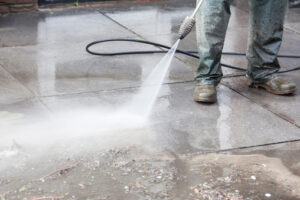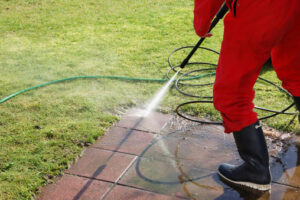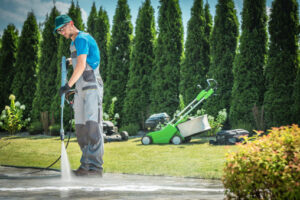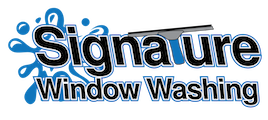 Are you looking for a way to make your home’s exterior look like new again? Pressure washing is becoming increasingly popular for cleaning the outside of a home. But what if there was an even easier way to do it? Softwashing with a pressure washer is the answer! It’s an effective and eco-friendly option that will have your home looking as good as new in no time. In this article, we’ll teach you how to softwash with a pressure washer safely and efficiently.
Are you looking for a way to make your home’s exterior look like new again? Pressure washing is becoming increasingly popular for cleaning the outside of a home. But what if there was an even easier way to do it? Softwashing with a pressure washer is the answer! It’s an effective and eco-friendly option that will have your home looking as good as new in no time. In this article, we’ll teach you how to softwash with a pressure washer safely and efficiently.
Softwashing has many advantages over traditional pressure washing, particularly when it comes to protecting delicate surfaces. The process uses low-pressure water combined with specialized cleaning agents that are designed to remove dirt and grime without damaging the surface or harming the environment. It’s also safer than traditional pressure washing methods since it doesn’t require the use of harsh chemicals. Plus, it can be done in less time and with less effort than regular pressure washing.
Once you know how to softwash with a pressure washer, you’ll be able to keep your home looking its best all year round! Read on to learn more about the process and find out why it’s becoming such a popular method for homeowners everywhere.
Understanding Softwashing
Softwashing is the process of using a pressure washer or power washer to clean surfaces with specialized detergents. It’s a technique that has been growing in popularity due to its ability to get into hard-to-reach areas and remove stubborn dirt and grime. To get started, you’ll need a pressure washer with a detergent tank and nozzle holder.
Before you begin softwashing, it’s important to understand the differences between traditional washing and softwashing. Traditional washing relies solely on the pressure of water to remove dirt, while softwashing uses special detergents designed specifically for cleaning purposes. The detergents are added directly into the pressure washer’s tank and mixed with water, which creates a more powerful cleaning solution than just water alone.
Once your equipment is ready, it’s time to start softwashing! Make sure you have all the right safety gear before getting started and take your time when working around delicate surfaces. Follow any instructions provided on the product label for best results. With proper preparation and care, you can use your pressure washer for effective softwashing that will leave your surfaces looking like new!
Benefits Of Softwashing With A Pressure Washer
Softwashing with a pressure washer offers many benefits that can’t be achieved with traditional washing methods. Pressure washers generate greater water pressure than power washers, which allows for more effective cleaning of dirt and grime. In addition, the use of detergents in pressure washing gives you access to specialized cleaning agents that can tackle even the toughest stains.
Using a pressure washer also has the advantage of bulk application. Instead of having to apply detergent to each surface individually, one application with a pressure washer can clean an entire area at once. This saves time and effort and makes softwashing an efficient way to keep your surfaces looking their best.
Finally, using a pressure washer for softwashing is safer than using traditional methods because it eliminates the need for hazardous chemicals or tools like ladders. By taking care when operating the equipment, you can reduce the risk of injury or property damage while achieving great results from your softwashing project.
Types Of Pressure Washers
Before beginning a softwashing project, it is important to understand the different types of pressure washers available. Pressure washers come in a range of sizes and capabilities, so it’s important to choose the right one for the job. For most residential projects, a standard power washing unit with a garden hose or light-duty pressure washer will do the trick. These units generate enough water pressure to effectively clean dirt and grime from surfaces like decks and patios. If you are cleaning tougher materials like vinyl siding or brick, then a higher-powered machine may be necessary.
When using a pressure washer for softwashing, you will also need to consider the type of detergent you use. Different detergents are designed for different surfaces and can help you achieve better results from your cleaning project. While most liquid detergents can be used with any type of pressure washer, some specialty detergents are designed specifically for certain materials or applications. Make sure to read the instructions on each product before purchasing to ensure that you get the best results possible from your softwashing project.
No matter what type of pressure washer or detergent you choose, make sure that it is suited for your specific needs before starting your softwashing project. With careful selection and use of proper techniques, you can successfully clean even the toughest surfaces with ease.
Safety Precautions For Softwashing
When softwashing with a pressure washer, it is important to take certain safety precautions. Although pressure washers can be an effective way to clean difficult surfaces, they can also cause serious damage if used incorrectly. To avoid any accidents or injuries, always make sure to read the instructions for your pressure washer before use and wear protective gear such as goggles and gloves. Additionally, use caution when applying detergents in bulk applications, as high concentrations of chemicals can be hazardous.
It is also important to be aware of your surroundings when softwashing. Make sure that there are no bystanders in the area and never point the nozzle of the pressure washer at anyone or any object that could be damaged by its force. Be sure to keep children and pets away from the work area at all times and never let them help with the cleaning process.
Finally, it is essential to follow the manufacturer’s instructions for both the pressure washer and detergent used during softwashing. Proper usage will ensure that you get optimal results from your project while minimizing potential risks or hazards associated with improper use of either product. When in doubt, consult a professional for help so that you can complete your project safely and successfully.
Setting Up The Pressure Washer
 Once you have taken all the necessary safety precautions, it’s time to set up your pressure washer for softwashing. Firstly, make sure that the power supply cord is properly connected and that the engine is switched off before you begin to set up the machine. Once this is done, attach any needed detergents and other cleaning materials to the pressure washer.
Once you have taken all the necessary safety precautions, it’s time to set up your pressure washer for softwashing. Firstly, make sure that the power supply cord is properly connected and that the engine is switched off before you begin to set up the machine. Once this is done, attach any needed detergents and other cleaning materials to the pressure washer.
Next, adjust the nozzle settings according to the manufacturer’s instructions. This will help ensure that you are using the correct amount of water force when softwashing surfaces with a pressure washer. Additionally, it is important to use bulk application detergents with caution. Applying too much of a cleaning chemical can cause damage to surfaces and should be avoided whenever possible.
Finally, check all connections and make sure that nothing has come loose during setup before turning on your pressure washer. Once everything is in place, you can start softwashing and enjoy a cleaner surface in no time!
Choosing The Right Cleaning Solutions
Choosing the right cleaning solutions is an essential part of softwashing with a pressure washer. It is important to select a detergent that is compatible with the surface you are cleaning, as well as one that will not cause damage to the environment. Pressure washer detergents are specifically designed for use with pressure washers and come in several different types.
For heavy-duty cleaning jobs, consider using a degreaser or an alkaline cleaner. These cleaners can help to break down dirt, grime, and other stubborn deposits on surfaces. For lighter-duty jobs, look for a mild soap or detergent that won’t strip away too much of the surface’s protective coating. Additionally, some pressure washer detergents contain special additives such as rust inhibitors or anti-fungal agents to help protect surfaces from further damage over time.
When selecting a pressure washer detergent, it is also important to pay attention to the instructions on how much product should be used for each job. Overusing detergents can result in unwanted residue being left behind and can even harm plants and animals nearby. By following manufacturer guidelines when selecting and using your pressure washer detergents, you can ensure better results with less waste!
Applying The Cleaning Solution Properly
Now that you have the right cleaning solution, it’s time to apply it properly. Applying the cleaning solution correctly will ensure that your softwashing job is both effective and efficient. Here are some tips to help you get started:
1) Start by testing a small area of the surface with your chosen cleaning solution. This will allow you to determine if the product is compatible with the material and if it can deliver the desired results.
2) Once you’ve determined the best cleaning solution for your job, it’s time to apply it using your pressure washer. Be sure to follow all manufacturer instructions regarding how much product should be used and at what pressure level. Additionally, consider investing in a foam cannon attachment for your pressure washer – this will allow you to apply an even coat of detergent for more effective results.
3) Lastly, let the cleaning solution dwell on the surface for some time before rinsing away with plain water. This should help loosen any stubborn dirt or grime while allowing you to use less water overall. Afterward, be sure to check your work and make sure no residue has been left behind before moving on to the next area!
Controlling Water Pressure
Now that you have applied the cleaning solution properly, it’s time to move on to controlling water pressure. This step is key in achieving the best results with your softwashing job. Here are a few tips to help you get started:
First, make sure to choose the correct nozzle size and type for the material you are cleaning. A larger nozzle will generate more pressure, while a smaller nozzle will create less pressure. The right choice of nozzle can make all the difference in your softwashing job, so be sure to do your research beforehand!
Second, use a variable-pressure trigger gun or wand attachment on your pressure washer. This will allow you to adjust the water flow quickly and easily depending on the surface or area you are working on. This way, you can avoid using too much or too little water for any given task.
Finally, always keep an eye on what’s going on around you when using a pressure washer. Avoid aiming at electrical outlets or windows, and be mindful of nearby plants and animals when applying water and cleaning solution as this could cause damage if not done correctly. Taking these precautions can save you time and hassle in the long run!
Rinsing Off The Cleaning Solution
Once you’ve finished applying the cleaning solution, it’s time to move on to rinsing off the surface. This step is essential for achieving optimal results with your softwashing job.
Rinsing off the cleaning solution should be done carefully and methodically. Start by using a gentle stream of water and slowly increase pressure as needed. Make sure to rinse thoroughly and evenly, paying special attention to any crevices or corners that may have been missed when applying the cleaning solution. Be sure to keep an eye out for any remaining residue from the cleaning solution and rinse it away until the surface is completely clean.
Finally, always take extra care when rinsing near windows, plants, electrical outlets, or other sensitive areas. This will help ensure that you don’t cause any damage while effectively removing all traces of cleaning solution from the surface. Taking these precautions can save you time and hassle in the long run!
Strategies To Improve Results
 When softwashing with a pressure washer, there are certain strategies and techniques you can use to maximize your results. To start, make sure that you’re using the right pressure setting for the job. Too much pressure can cause damage to the surface, while too little will not yield effective results. As such, it’s important to find a balance between the two and adjust as needed during the cleaning process.
When softwashing with a pressure washer, there are certain strategies and techniques you can use to maximize your results. To start, make sure that you’re using the right pressure setting for the job. Too much pressure can cause damage to the surface, while too little will not yield effective results. As such, it’s important to find a balance between the two and adjust as needed during the cleaning process.
Additionally, you can improve your softwashing job by making sure to pre-treat any difficult stains or areas of heavy buildup prior to applying the cleaning solution. This will help break down tough dirt and grime and make them easier to remove when rinsing away the solution.
Finally, be sure to use protective equipment when softwashing with a pressure washer. Wear safety glasses or goggles and gloves at all times, as well as long sleeves and pants if necessary. This will help keep you safe from potential hazards that may result from operating a pressure washer in an enclosed space or near hazardous materials. Taking these precautions can help ensure that your softwashing job is done safely and effectively!
Correctly Storing The Equipment
Once you’ve finished your softwashing job, it’s important to properly store the equipment. This will help ensure its longevity and make it easier to use again in the future.
First of all, make sure that all pressure washer parts are cleaned and dried thoroughly before storing them away. This will help prevent any rust or corrosion from forming on the machine over time, and also reduce the chances of the machine malfunctioning due to dirt or grime buildup. Additionally, check that all hoses and connections are securely fastened before putting them away.
It’s also a good idea to store your pressure washer in a cool, dry area where it won’t be exposed to extreme temperatures or direct sunlight. This will keep the machine in optimal condition for longer periods of time, as well as help protect its internal components from damage caused by exposure to harsh elements. Additionally, if you have any remaining cleaning solution left over, make sure to store it separately from the pressure washer itself so that it doesn’t cause any damage to the machine’s parts or seals.
By following these steps you can help ensure that your pressure washer is stored safely and correctly and ready for use when you need it next!
Maintaining A Pressure Washer
Maintaining a pressure washer is key to ensuring it works properly and lasts longer. To ensure your equipment is functioning correctly, here are some steps you should follow regularly.
First of all, you should check the oil levels in the engine before each use. This will prevent damage caused by too little or too much oil in the system. Additionally, make sure to inspect hoses and connections for any tears or cracks that could lead to leaks. You should also inspect the valve seals on a regular basis to make sure they are still in good condition.
Another important maintenance task is cleaning out the pressure washer filter after each use. This can help extend the life of the machine by preventing dirt and debris from getting into its internal parts and causing damage. Additionally, if you’re using a gas-powered pressure washer, be sure to check and replace spark plugs when necessary to keep the engine running smoothly and efficiently.
Finally, taking care of your pressure washer means keeping it clean on a regular basis. This includes wiping down its surfaces with a damp cloth after each use, as well as periodically rinsing out its hose connections with a garden hose or power sprayer to get rid of any dirt buildup in hard-to-reach areas. By following these tips and performing regular maintenance checks on your equipment, you can help extend its lifespan and ensure it functions properly for years to come!
Troubleshooting Tips And Techniques
When it comes to softwashing with a pressure washer, there are a few things to keep in mind. First, it’s important to understand the difference between a pressure washer and a softwashing system. Pressure washers use high-pressure water jets to blast away dirt and debris from surfaces, while softwashing systems use low-pressure water and detergent solutions to gently clean surfaces. Knowing which system is best for your project can help you avoid costly mistakes and ensure the job is done correctly.
In addition, troubleshooting tips and techniques can come in handy when dealing with any issues that may arise when using a pressure washer or softwashing system. For instance, if you’re having trouble getting the desired results, try adjusting the nozzle or changing the angle of the sprayer. You can also experiment with different detergents until you find one that works best for your project. It’s also important to check for clogs in hoses or filters as these can prevent proper cleaning power from reaching your surface.
Finally, safety should always be top of mind when working with pressure washers or softwashing systems. Be sure to wear appropriate protective clothing such as gloves, goggles, and long sleeves whenever possible. Additionally, make sure you’re aware of any potential hazards in your work area and take necessary precautions to avoid them. By following these tips and taking proper safety measures, you can help ensure your projects are completed safely and efficiently!
Professional Softwashing Services
For those looking for professional softwashing services, there are a few things to consider. Firstly, it’s important to find a company that specializes in softwashing and has experience doing so. This ensures they know the best techniques and products to use for your project. Additionally, make sure they have the right equipment and safety protocols in place. It’s also worthwhile asking questions about their process, such as whether they use eco-friendly detergents, or what measures they take to prevent damage to your property during the job.
When it comes to cost, be sure to get quotes from several companies before making a decision. Ask for a breakdown of services included in the quote and any additional fees that may apply. Doing this can help you decide which company is best suited for your project without breaking the bank.
Finally, always make sure you read reviews from past customers before hiring a company for softwashing services. This can give you an idea of their reputation and help you determine whether they’re the right choice for your needs. Taking these steps will help ensure you find the best softwashing service provider possible!
Cost-Effective Alternatives
For those looking for a more cost-effective alternative, pressure washing can be a great solution. The process involves using high-pressure water to clean off dirt, grime and other contaminants from surfaces. It’s important to note that pressure washing can damage certain materials if done incorrectly, so it’s best to consult with a professional before attempting this method.
Another option to consider is using eco-friendly detergents and cleaning solutions. These products are specifically designed to lift dirt and grime without damaging the material they’re being applied to. Many of them are also biodegradable, making them an environmentally friendly choice. Additionally, eco-friendly detergents tend to be less expensive than other options, making them a great budget-friendly choice for softwashing projects.
When it comes to selecting the right method for your softwashing needs, it’s important to weigh all the available options carefully. Consider factors such as cost, time spent on the job and any potential risks associated with each technique before making a decision. Taking these steps will help ensure you get the best results possible!
Conclusion
 Softwashing with a pressure washer is an effective way of cleaning and sanitizing outdoor surfaces. It is important to understand the basics of softwashing, the types of pressure washers available, the safety precautions needed, and how to properly set up and maintain a pressure washer for softwashing. Additionally, knowing some troubleshooting tips can be invaluable when dealing with any issues that may arise. Professional softwashing services are available for those who are not comfortable or experienced enough to do it themselves. But for those who prefer to do it themselves, there are some cost-effective alternatives on the market today. With proper knowledge and preparation, softwashing with a pressure washer can provide many benefits and help keep outdoor surfaces clean and sanitized.
Softwashing with a pressure washer is an effective way of cleaning and sanitizing outdoor surfaces. It is important to understand the basics of softwashing, the types of pressure washers available, the safety precautions needed, and how to properly set up and maintain a pressure washer for softwashing. Additionally, knowing some troubleshooting tips can be invaluable when dealing with any issues that may arise. Professional softwashing services are available for those who are not comfortable or experienced enough to do it themselves. But for those who prefer to do it themselves, there are some cost-effective alternatives on the market today. With proper knowledge and preparation, softwashing with a pressure washer can provide many benefits and help keep outdoor surfaces clean and sanitized.

Recent Comments